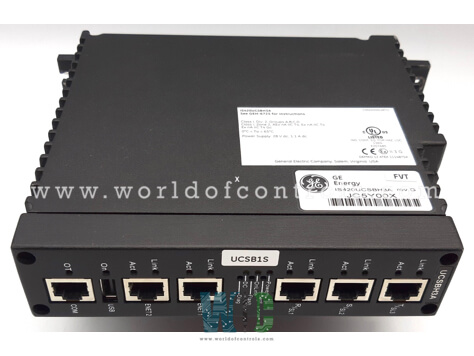
World Of Controls understands the criticality of your requirement and works towards reducing the lead time as much as possible.
IS421UCSBH3A - UCSB Controller Module is available in stock which ships the same day.
IS421UCSBH3A - UCSB Controller Module comes in UNUSED as well as REBUILT condition.
To avail our best deals for IS421UCSBH3A - UCSB Controller Module, contact us and we will get back to you within 24 hours.
SPECIFICATIONS:
Part Number: IS421UCSBH3A
Manufacturer: General Electric
Series: Mark VIeS
Product Type: UCSB Controller Module
Microprocessor: 1200 MHz Intel EP80579
Memory: 256 MB
Operating System: QNX Neutrino
Programming: Boolean
Primary Ethernet Interface: 10Base-TX/100Base-TX
Operating temperature: -30 to 65 °C
Size: 10.16 cm wide x 33.02 cm
Repair: 3-7 Days
Availability: In Stock
Country of Origin: United States
Manual: GEH6721
FUNCTIONAL DESCRIPTION:
IS421UCSBH3A is a UCSB Controller Module manufactured and designed by General Electric as part of the Mark VIeS Series used in GE Distributed Control Systems. The UCSB controllers are stand-alone computers that run the application code. The controller mounts in a panel, and communicates with the I/O packs through on-board 1/0 network (IONet) interfaces. IONet is a private special-purpose Ethernet that only supports Mark controls I/O modules and controllers. The controller operating system (OS) is QNX Neutrino, a real-time, multitasking OS designed for high-speed, high-reliability industrial applications. Unlike traditional controllers, where I/O is on a backplane, the UCSB controller does not host any application I/O.
Also, all I/O networks are attached to each controller, providing them with all input data. The hardware and software architecture guarantees that no single point of application input is lost if a controller is powered down for maintenance or repair. The Mark VIeS UCSBH3A Safety Controller and Safety 1/0 modules are used for functional safety loops to achieve SIL 2 and 3 capabilities. Mark VleS Safety equipment is used by operators knowledgeable in safety-instrumented systems (SIS) applications to reduce risk in critical safety functions. Safety controllers and distributed I/O modules are programmed specifically for safety control use, and this specific control hardware and software have IEC 61508 certification.
INSTALLATION:
The IS421UCSBH3A UCSB Controller Module is designed as a single, self-contained unit that mounts directly to the panel sheet metal, simplifying installation and minimizing hardware requirements. Its compact design allows for efficient space utilization within control cabinets while maintaining strong mechanical stability. To ensure proper heat dissipation, the controller must be installed in a vertical orientation with unobstructed airflow through the cooling fins. This configuration promotes consistent cooling and prevents overheating during continuous operation. It is important to review the module envelope and mounting dimensions provided in the GE manual, where all measurements are given in inches for precise alignment. The panel surface should be flat, rigid, and properly grounded to reduce electrical interference. Maintain sufficient clearance around the controller for ventilation and service access, and confirm that all cables are securely connected to the appropriate ports.
UCSB SOFTWARE AND COMMUNICATIONS:
The controller is loaded with software specific to its application. It can run on rungs or blocks. Minor modifications to the control software may be made online without requiring a restart. The IEEE 1588 protocol is used through the R, S, and T IONets to synchronize the clock of the I/O packs and controllers to within 100 microseconds. External data is transferred to and from the control system database in the controller over the R, S, and T IONets. This includes process I/O to the I/O modules.
World of Controls maintains the largest stock of OEM replacement parts for GE Distributed Turbine Control Systems, including unused, rebuilt, and refurbished boards—all backed by a reliable warranty. In addition to supplying high-quality parts, we offer expert repair services for faulty modules, helping you minimize downtime and extend equipment life. Our team of skilled engineers is available 24/7 to provide technical support, guidance, and solutions for all your OEM and automation needs. For pricing, availability, or repairs, contact us by phone or email, and our specialists will assist you promptly and professionally.
What type of power supply does the UCSB Controller Module require?
The UCSB Controller Module typically requires a DC power supply. It may range from 12V to 48V, depending on the model. Be sure to consult the datasheet or user manual for the exact power requirements.
What is the input voltage range for the UCSB Controller Module?
Input voltage varies by model but typically falls within a range of 24V DC or 48V DC. Some models may support a wider range. Always check the specifications for the exact voltage limits.
Is the UCSB Controller Module compatible with different types of sensors?
Yes, the UCSB Controller Module is generally compatible with various sensors, including temperature, pressure, flow, and level sensors, depending on the application. The sensors usually communicate with the module via standard industrial protocols like Modbus or analog signals (4-20mA or 0-10V).